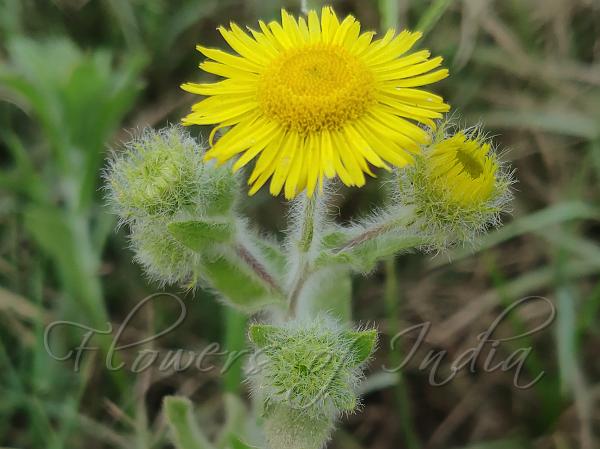|
| Common Fleabane |
|

|

| File size | 588722 |
| Original date | 3/17/23 4:57 PM |
| Resolution | 4608 x 3456 |
| Flash | Flash did not fire |
| Focal length | 4.05mm |
| Exposure time | 1/148s |
| Aperture | 1.78 |
| Focus Distance | |
| Metering Mode | $meteringMode |
| Camera make | Lenovo |
| Camera model | Lenovo L38111 |
| Sensor type |
|
|
|
|
Photo: |
Botanical name: Pulicaria dysenterica Family: Asteraceae (Sunflower family)
Synonyms: Inula dysenterica
Synonyms: Inula dysenterica
Common Fleabane is a perennial herb with stems 20-60
cm tall, branched, woolly and sparsely glandular, in lower part less
densely velvet-hairy. Leaves are stalkless, soft, 1.7-6 x 0.7-2.3 cm,
most lower leaves oblong or inverted-lanceshaped, narrowed to base,
other stem leaves lanceshaped, with eared profoundly heart-shaped and
slightly stem-clasping base, thinly gray woolly or almost woolly below,
green and rough above, with short stalkless fine tuberculate hairs,
rarely nearly hairless, margin almost entire or slightly wavy.
Flower-heads are 3-15 per plant, in loose, corymb-like or raceme-like
clusters, on rather long woolly flower-cluster-stalks, 2-6 mm.
Involucre is semispherical, 1.1-1.5 cm in diameter; phyllaries
numerous, in 5 or 6 series, linear, long and tapered-tapering at tip,
almost thread-like, sometimes, mostly outer ones, woolly-hairy,
sparsely hairy or nearly hairless inside. Ray florets are about twice
as long as involucre and almost 3 times as long as tubular disk
florets; florets are 8-11 mm, sparsely glandular outside, mainly in
upper part; blade unbent, 1-1.3 mm wide, longitudinally 4-veined. Disk
florets are tubular, 3.5-4.5 mm. seed-pods are oblong, 1.25-1.5 x
0.3-0.4 mm, slightly compressed. Common Fleabane is found in Europe and
N. Africa, eastwards to Himalaya and Nepal, at altitudes of 250-2000 m.
Flowering: June-September.
Medicinal uses: The bruised leaves have a
soap-like smell. They are astringent and can be used in the treatment
of dysentery. The root is also astringent and used in the treatment of
dysentery. A paste of the plant is applied externally to wounds.
The bruised leaves have a
soap-like smell. They are astringent and can be used in the treatment
of dysentery. The root is also astringent and used in the treatment of
dysentery. A paste of the plant is applied externally to wounds.
Medicinal uses:
 The bruised leaves have a
soap-like smell. They are astringent and can be used in the treatment
of dysentery. The root is also astringent and used in the treatment of
dysentery. A paste of the plant is applied externally to wounds.
The bruised leaves have a
soap-like smell. They are astringent and can be used in the treatment
of dysentery. The root is also astringent and used in the treatment of
dysentery. A paste of the plant is applied externally to wounds. | Identification credit: Sushain Babu, Tabish | Photographed in Pheena, Bijnor, Uttar Pradesh. |
• Is this flower misidentified? If yes,